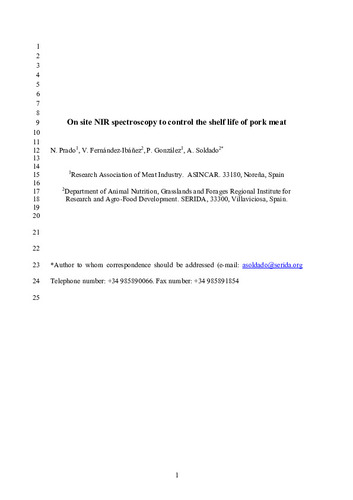On site NIR spectroscopy to control the shelf life of pork meat
Autor(es) y otros:
Palabra(s) clave:
Near infrared reflectance spectroscopy, pork, meat, food preservation
Fecha de publicación:
Versión del editor:
Citación:
Resumen:
Control of meat shelf-life includes the time that it remains in the exhibitor of sale (such as the supermarket) until its rejection for the consumer, or withdrawal due to expiry date. Near infrared spectroscopy (NIRS) is one of the most promising techniques for large-scale meat quality control. This study investigated the potential of on-site NIRS portable instrumentation based models to predict three microbiological parameters to establish if pork meat is acceptable or not for consumption (aerobic Mesophilous microorganisms, Enterobacteriae and lactic acid bacteria) and pH to quality control food preservation and shelf life extension on intact slices of pork meat packaged under two different modified atmospheres. NIR calibrations were developed by using an on-site Phazir instrument (Polycromix,Wilmington, USA) in the range 1600-2400nm. A total of 252 samples of pork meat slices were directly scanned twice in reflectance mode on trays, once before and other one after removing the film cover at 1, 3, 5, 7, 9, 12 and 15 days of storage. Results showed that spectra of meat acceptable or not for 15 consumption have marked differences around 1660 nm. NIRS quantitative prediction models showed r2 values between 0.19-0.65 for the microbiological parameters assayed. The developed NIRS methodology makes possible on-site prediction of microbiological status of pork meat with and standard error of cross validation around 1 Log cfu/g. Results have shown that there are not influence of MAP (modified atmosphere packaging) on calibration statistics.
Control of meat shelf-life includes the time that it remains in the exhibitor of sale (such as the supermarket) until its rejection for the consumer, or withdrawal due to expiry date. Near infrared spectroscopy (NIRS) is one of the most promising techniques for large-scale meat quality control. This study investigated the potential of on-site NIRS portable instrumentation based models to predict three microbiological parameters to establish if pork meat is acceptable or not for consumption (aerobic Mesophilous microorganisms, Enterobacteriae and lactic acid bacteria) and pH to quality control food preservation and shelf life extension on intact slices of pork meat packaged under two different modified atmospheres. NIR calibrations were developed by using an on-site Phazir instrument (Polycromix,Wilmington, USA) in the range 1600-2400nm. A total of 252 samples of pork meat slices were directly scanned twice in reflectance mode on trays, once before and other one after removing the film cover at 1, 3, 5, 7, 9, 12 and 15 days of storage. Results showed that spectra of meat acceptable or not for 15 consumption have marked differences around 1660 nm. NIRS quantitative prediction models showed r2 values between 0.19-0.65 for the microbiological parameters assayed. The developed NIRS methodology makes possible on-site prediction of microbiological status of pork meat with and standard error of cross validation around 1 Log cfu/g. Results have shown that there are not influence of MAP (modified atmosphere packaging) on calibration statistics.
ISSN:
Colecciones
Ficheros en el ítem




